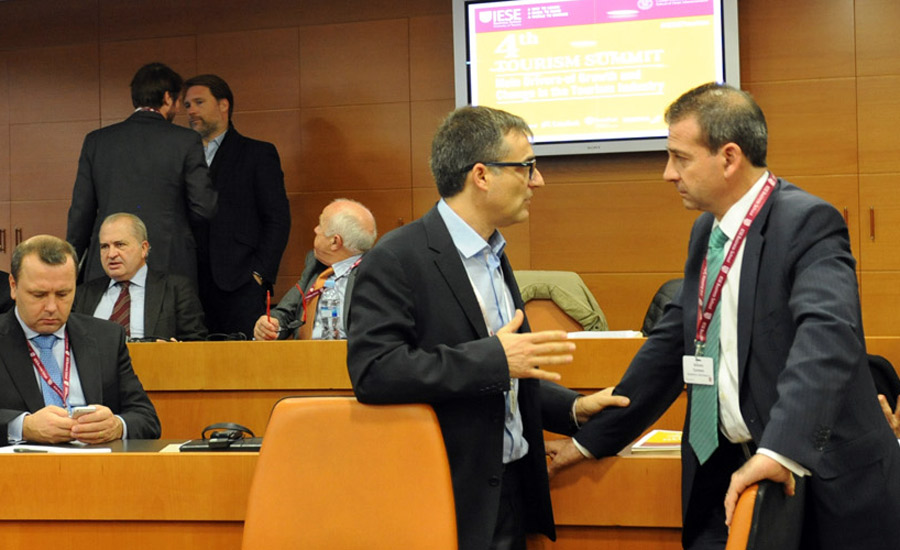
Key tourism industry confirm its going from strength to strength at present. Its healthy growth and bright prospects are thanks to momentum from China, innovation and the new trends millennial tourists are setting.
The main drivers of the industry's growth and change were analyzed at IESE's 4th Tourism Summit. Organized in conjunction with Cornell University's School of Hotel Administration, the summit took place at IESE Barcelona campus.
China: Opportunities in Both Directions
China is the world's largest domestic market with an emerging middle class increasingly inclined to travel and spend. China is also its top source of tourists – 120 million per year. And its leading investor, with a growing involvement in the tourism industry. It is no surprise, then, that one of the summit's most eagerly anticipated sessions focused on China's impact on the tourism industry. And vice versa.
“There are opportunities in both directions,” said Eric Wu, CFO and board director of Plateno Group. “Firstly, the number of Chinese tourists visiting Europe is set for a very significant rise.” Forecasts for China's tourism market indicate an average annual growth rate of 8 percent over the next decade. Yet, said Wu, “Only 11 or 12 percent of Chinese tourists travel to Europe, with the majority opting for destinations closer to home, such as Hong Kong, Macao and Taiwan.”
Secondly, more and more large Chinese firms are establishing strategic partnerships with, or buying into, European companies.
“The aim is twofold,” said Jordi Martí, co-founder and managing partner of Drac Capital. “It’s not only about seeing more Chinese tourists in Europe. It’s about acquiring the brands, know-how and technology developed by the more established and mature European tourism sector. Then transferring this to China's emerging national tourism market.”
The case of Plateno Group illustrates both trends perfectly. Its recent merger with Jin Jiang created China's biggest hotel group, a giant boasting more than 6,000 hotels and 640,000 rooms. It instantly became one of the world's ten largest hotel chains. A ranking currently headed by Marriott (whose purchase of Starwood has propelled it into first position), IHG and Hilton. Given the constant trickle of Chinese capital into European tourism companies, this ranking could soon be led by a Chinese group.
The partnerships of Plateno and Jin Jiang with the Spanish hotel chains Barceló and Meliá respectively highlight this trend. Further examples are the Chinese group HNA's majority holding in NH Hotel Group; the joint venture between the Chinese online agency Ctrip and the Norwegian firm Royal Caribbean to form SkySea Cruises to serve the Chinese cruise market; and the Chinese conglomerate Fosun's acquisitions of 51 percent of Thomas Cook and 100 percent of Club Med.
“High-value strategic agreements between major operators are not the only opportunities available,” said Marti. “We're talking about smaller deals in different parts of the value chain too.”
“There are great opportunities involved in developing very specific niche markets,” said Wu. In particular those targeting Chinese millennials. Unlike previous generations, their language skills make them more comfortable travelling. They also value spending more time getting to know the countries they visit, rather than touring a dozen countries in ten days. And they seek unique experiences, for which they are willing to pay more.
“European operators entering the Chinese market should concentrate on a very precise segment,” said Steve Qi, managing partner of Eatonbridge Capital. “Plateno controls the low-cost hotel market. And competition is very fierce where five-star hotels are concerned because all the major luxury chains positioned themselves some time ago”.
Enterprising Chains
Established European tourism operators, meanwhile, are looking to make the most of their presence and experience in the industry. Not only through strategic partnerships with Chinese investors, but also by means of intrapreneurship aimed at seizing opportunities for growth stemming from sociological changes, such as the sudden emergence of millennial tourists. Technological progress – digitization, e-commerce, mobility services – and the market's globalization, the internationalization of supply and the provision of complementary services, are also tools European tourism operators hope to harness.
Hotusa, HotelBeds and Grupo Satocan all show the benefits of such opportunities. They lead to the creation of business units specifically designed to cover new areas and segments (for internal use or for offering services to third parties), investment in start-ups related to the investor's business model, and other corporate venturing initiatives that pave the way for cooperation between entrepreneurs and major corporations and help bring innovation into the sector.
“For corporations, access to innovation has huge potential and costs very little,” said Ángel García, founding partner of Lanta Digital Ventures. “And none of Airbnb, Booking.com or Uber was a sector corporation's brainchild.”